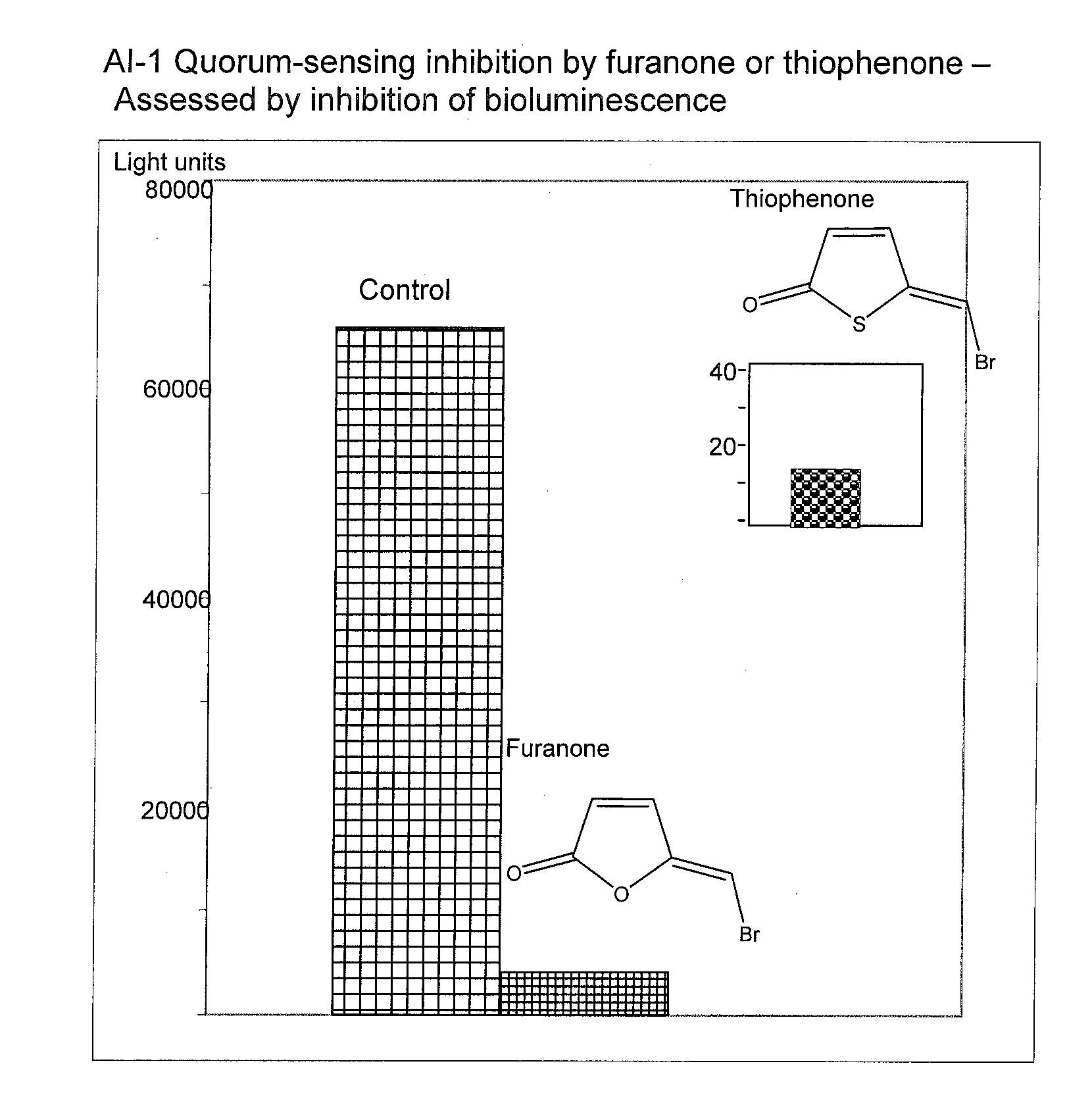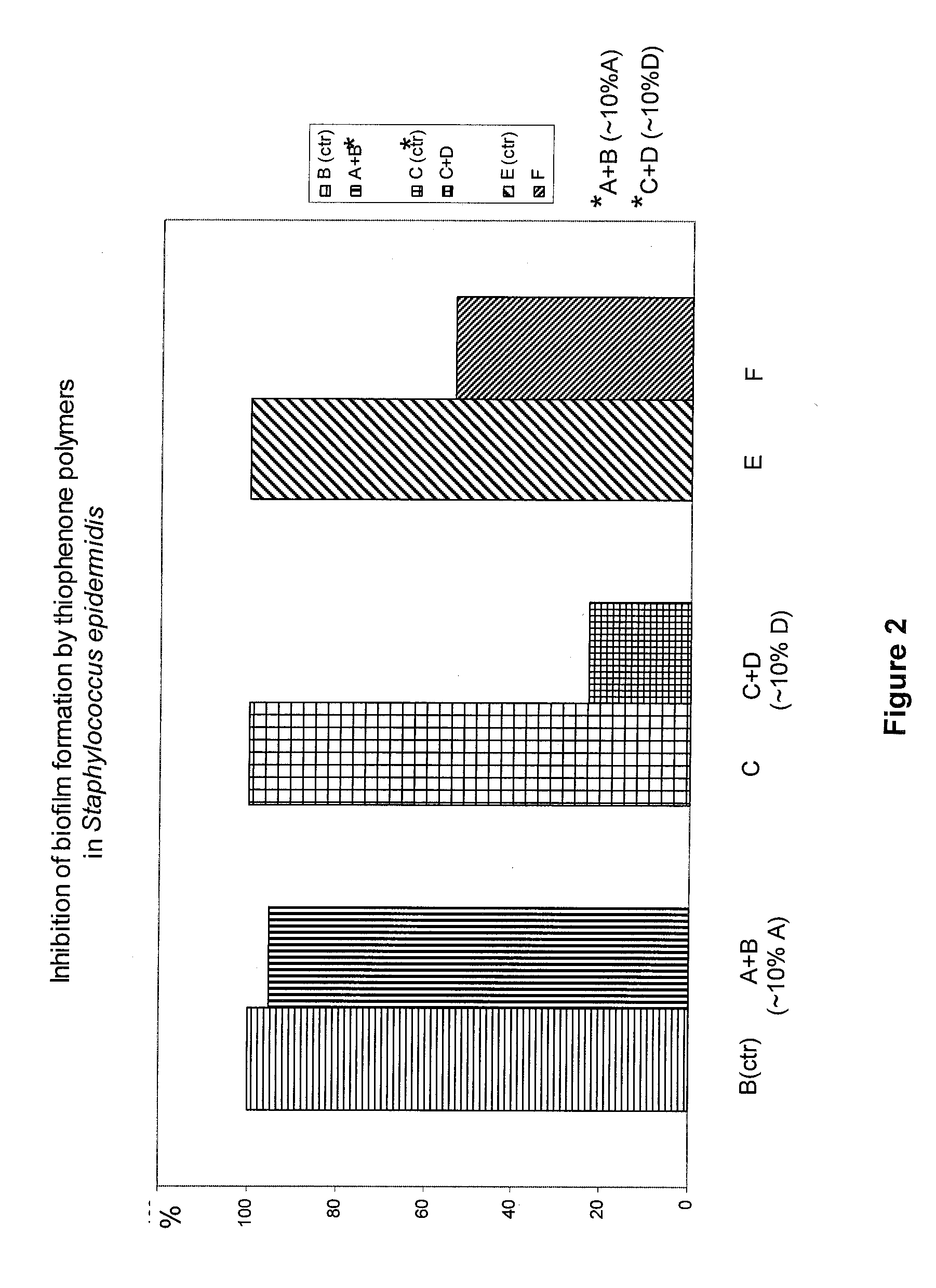Antimicrobial compositions and uses
a technology of compositions and antimicrobials, applied in the field of antimicrobial compositions, can solve the problems of biofilm formation and biofouling, economic losses in domestic, industrial and health fields, and various human and animal infections, and achieve the effect of inhibiting or preventing biofilm formation
- Summary
- Abstract
- Description
- Claims
- Application Information
AI Technical Summary
Benefits of technology
Problems solved by technology
Method used
Image
Examples
example 1
[0048]This example relates to the synthesis of the thiophenones. The compound codes (e.g. Thio101) correspond to those set out in Table 1.
[0050](E)- and (Z)-5-Bromomethylenethiophen-2(5H)-one. Acetyl bromide (0.5 mL) was added dropwise at 0° C. to a solution of 5-formyl-2-methoxythiophene1 (142 mg) in CDCl3 (1.0 mL) The mixture was stirred at 0° C. for 1.5 h before it was evaporated. The crude product was purified by flash chromatography using hexane / ethyl acetate 5:1 as eluent. Yield (E)-5-bromomethylenethiophen-2(5H)-one: 9 mg. Yield (Z)-5-bromomethylenethiophen-2(5H)-one: 86 mg. The identity of the compounds were confirmed by mass spectrometry and NMR.
[0051]Thio103
[0052](Z)-5-Choromethylenethiophen-2(5H)-one. Acetyl chloride (2 mL) was added to 5-formyl-2-methoxythiophene1 (142 mg). The mixture was stirred at room temperature over night before it was evaporated. The crude product was purified by flash chromatography using hexane / ethyl acetate 5:1 as eluen...
example 2a
[0087]This example describes the effect of thiophenones on biofilm formation by various bacteria. Biofilm formation was measured according to a static biofilm model and according to a shaking biofilm model and it was shown that the various thiophenones tested were found to inhibit or prevent biofilm formation.
[0088]According to the static biofilm model, a given thiophenone 200 μmol / L was dissolved in 500 μl absolute ethanol and applied to wells of a standard 24 well microtiter plate. The ethanol was evaporated from the wells in a laminar air sterile work bench at room temperature so as to leave a coating of the thiophenone in the well. A sample of bacteria was then added to the well and incubated for a given period of time. After incubation, the percentage of bacteria remaining was assessed by safranine staining of the biofilm. Bound safranine was released by acetic acid and optical density was measured in Synergy HT Multi-Detection Microplate Reader and compared to a control. The r...
example 2b
[0092]This example describes the effect of further thiophenes on biofilm formation and planktonic growth by various bacteria.
[0093]Planktonic growth was determined in “Low Binding Plates” in which the bacteria form minimal amounts of biofilm The quantity is determined by optical density measurements at 600 nm.
[0094]Biofilm formation was measured in static cultures in wells of microtiter plates for S. epidermidis, or on “peggs” according to the Calgary method (The Calgary biofilm devices: New technology for rapid determination of antibiotic susceptibilities of bacterial biofilms. Ceri et al. J Clin Microbiol 1999:37:1771-1776) for V. harveyi. In both cases the safranin staining method was applied and optical density was measured at 530 nm for quantification of biofilm mass.
[0095]This compound was synthesized as follows:
[0096]Hünig's base (155 mg, 1.2 mmol) and DMAP (catalytic amount, ˜10 mg) was dissolved in 2 mL DCM and added to a solution of succinic anhydride (120 mg, 1.2 mmol) an...
PUM
| Property | Measurement | Unit |
|---|---|---|
| temperature | aaaaa | aaaaa |
| temperature | aaaaa | aaaaa |
| temperature | aaaaa | aaaaa |
Abstract
Description
Claims
Application Information
 Login to View More
Login to View More - R&D
- Intellectual Property
- Life Sciences
- Materials
- Tech Scout
- Unparalleled Data Quality
- Higher Quality Content
- 60% Fewer Hallucinations
Browse by: Latest US Patents, China's latest patents, Technical Efficacy Thesaurus, Application Domain, Technology Topic, Popular Technical Reports.
© 2025 PatSnap. All rights reserved.Legal|Privacy policy|Modern Slavery Act Transparency Statement|Sitemap|About US| Contact US: help@patsnap.com



